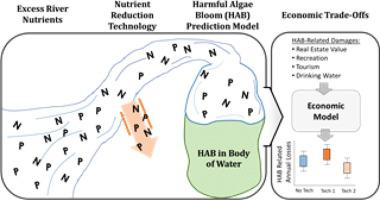Journal of Great Lakes Research ( IF 2.4 ) Pub Date : 2021-05-14 , DOI: 10.1016/j.jglr.2021.04.011 Katherine K. DeRose , Ryan W. Davis , Eric A. Monroe , Jason C. Quinn

|
Harmful algal blooms (HABs) affect fresh and saltwater bodies around the world, causing a variety of damages to the surrounding communities. The primary driver of HABs is nutrient pollution. One novel HAB mitigation solution is to employ large-scale attached algal growth systems that consume nutrients from the water and prevent downstream nutrient accumulation and large scale HAB events. The feasibility of technology deployment is dependent on the economic viability. A model was created to estimate HAB-related economic damages, with or without non-point source nutrient reduction solutions, using Lake Erie as a case study. In the model, HAB severity is predicted based on nutrient loads and is tied to economic indicators to estimate the HAB-related economic losses. Results show that on average, Lake Erie communities lose $142 M (± $29 M) year−1 from HABs without mitigation technology. Use of attached algal systems show an average net savings ranging between $29–42 M year−1 from HAB mitigation depending on the system configuration. Attached algal systems show greater positive cash flows when compared to farm-based best management practices, thus warranting additional testing and consideration as a potential HAB mitigation strategy. Additional considerations included stochastic uncertainty and increasing dissolved reactive phosphorus concentrations, which increased the effectiveness of attached algal systems.
中文翻译:

通过附着藻类生长来减缓有害藻华的经济可行性
有害藻华 (HAB) 影响世界各地的淡水和咸水体,对周围社区造成各种破坏。HAB 的主要驱动因素是养分污染。一种新的 HAB 缓解解决方案是采用大规模附着藻类生长系统,该系统消耗水中的养分并防止下游养分积累和大规模 HAB 事件。技术部署的可行性取决于经济可行性。使用伊利湖作为案例研究,创建了一个模型来估计与 HAB 相关的经济损失,无论是否采用非点源养分减少解决方案。在该模型中,HAB 严重程度是根据养分负荷预测的,并与经济指标挂钩,以估计与 HAB 相关的经济损失。结果显示,伊利湖社区平均每年损失 1.42 亿美元(± 2900 万美元)-1来自没有缓解技术的 HAB。根据系统配置,使用附着藻类系统表明从 HAB 缓解中平均净节省 29-4200 万美元-1 年不等。与基于农场的最佳管理实践相比,附加藻类系统显示出更大的正现金流,因此需要额外的测试和考虑作为潜在的 HAB 缓解策略。其他考虑因素包括随机不确定性和增加溶解的活性磷浓度,这增加了附着藻类系统的有效性。











































 京公网安备 11010802027423号
京公网安备 11010802027423号